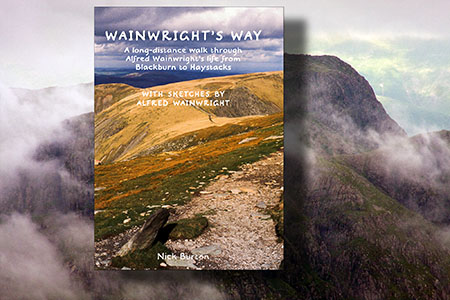Wainwright’s Way
Nick Burton
In death, possibly even more than in his life, Alfred Wainwright’s influence on the outdoors endures, with acolytes of the taciturn treasurer dissecting and analysing the author in new ways every year.
Nick Burton’s book, part guidebook, part biography, part history, traces a route from birth to death – in fact beyond death – charting Wainwright’s celebrated escape from the industrial grime of a Lancashire mill town to the towering fells of the Lake District which were to be his real love, some might say obsession.
Burton’s thesis is that Wainwright’s desire to escape the grim confines of mid-20th-century Blackburn gave him the impetus to create his now renowned series of pen-and-ink guidebooks and that only an urban dweller could have produced.
Wainwright’s Way charts a 203km (126-mile) route from the dubious attractions of a now post-industrial Blackburn to the heights of the Lakeland fell Hay Stacks, where Alfred’s ashes were scattered.
Burton, a walk leader with Blackburn Council, has devised the route which heads northwards from Wainwright’s birthplace through the Pennine hills of Lancashire, the wild and boggy fells of Bowland and the Kent Valley to Kendal, the writer’s home from his leaving of Blackburn to his death.
Naturally, his Kendal residences are visited before moving on to an ascent of Orrest Head near Windermere, said by Wainwright to be a life-changing event in his life.
Into the Lake District proper, the route takes in High Street, Patterdale, Grasmere, the Langdale Pikes, Rosthwaite, Honister and Hay Stacks – Wainwright’s favourite fell – before a final descent to the village of Buttermere.
As you would expect from a walking guide, Burton provides a wealth of information: historical, geographic, anecdotal and biographical, to make the book a comprehensive guide to the route.
Wainwright’s Way has plenty of Alfred’s original sketches and Burton provides his own sketch maps of the route.
Sadly, his drawing skills are no match for Wainwright’s and the maps look clumsy and amateurish in comparison. But they do at least give an indication of the route to be followed but are certainly not good enough to be relied on for navigation, nor are they meant to be.
Curiously, the chapter titles are in ‘Wainwright script’ so someone can do a good impression of his penmanship.
The route is divided into 10 sections so could be walked fairly leisurely over 10 days. Each chapter ends at a settlement where it is possible to find accommodation.
The book has an index and bibliography and is a similar size to Wainwright’s own pocket guides, so would not take up much space in the rucksack.
Will Wainwright’s Way catch on as a long-distance route? It’s an interesting concept, which will undoubtedly appeal to die-hard Wainwright fans who want a comprehensive insight into the places that were his haunts.
Not everyone will want to mix the joys of Blackburn with the solitude of Greenup Edge, but even without doing the complete route, many walkers will find much to keep their interest on Wainwright’s Way.
Wainwright’s Way
Published by Frances Lincoln
Hardback, 312 pages
Price: £13.99
